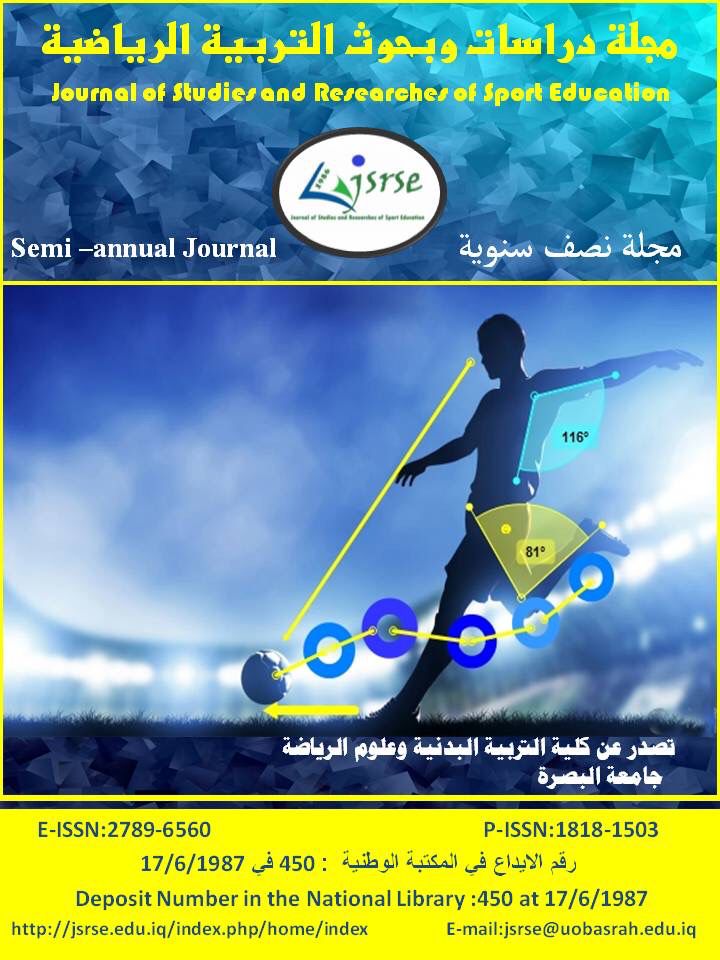الأنماط المزاجية لدى لاعبات كرة القدم في فلسطين
محتوى المقالة الرئيسي
الملخص
هدفت الدراسة إلى التعرف على الأنماط المزاجية لدى لاعبات كرة القدم في فلسطين، بالإضافة إلى تحديد الفروق بين الأنماط المزاجية تبعاً لمتغير الخبرة في اللعب ومركز اللعب. ولتحقيق ذلك أجريت الدراسة على عينة قوامها (57) لاعبة تم اختيارهن بالطريقة العشوائية البسيطة، وتم استخدام المنهج الوصفي لذلك، وطبق عليها قائمة الأنماط المزاجية للرياضيين والمكونة من (30) فقرة. وتوصلت نتائج الدراسة أن مستوى الأنماط المزاجية لدى اللاعبات جاء (متوسط)، وكذلك يتضح من الدراسة أن بعد المرونة الشخصية جاء في المرتبة الأولى، وفي المرتبة الثانية بعد عمليات الإثارة وبعد عمليات الكف، فيما أظهرت النتائج وجود فروق ذات دلالة إحصائية في الأنماط المزاجية المميزة لدى لاعبات كرة القدم في فلسطين تعزى إلى متغير الخبرة في اللعب على بعد قوة عمليات الإثارة، وعدم وجود فروق تعزى إلى متغير مركز اللعب. وأوصى الباحثون بعدة توصيات من أهمها: ضرورة إخضاع اللاعبات إلى مواقف متنوعة من الضغوط النفسية لهدف حسن التكيف لديهم في مختلف المواقف
تفاصيل المقالة

هذا العمل مرخص بموجب Creative Commons Attribution-NonCommercial 4.0 International License.
المراجع
AbdulRasoul, T. H., Aldewan, L. H., & Muslim, A. J. (2019). Effect of Daniel ’s model in teaching basic skills of football halls. Journal of Studies and Researches of Sport Education, 58, 11–25.
Ahmed, A. Y. A.-R. (2016). Temperamental Pattrens and their Relationship to the Distinctive Psychological Skills of Karate Players,. International Scientific Conference, Sport Is a Regular Part of a Lifestyle.
Ali, I. H., Aldewan, lamyaa hasan, & AbdelHussein, F. H. (2019). The effect of using the Closemire model according to the cognitive method (impulsive versus speculative)In learning some skills with gymnastic on a device Balance beam for female students. Journal of Studies and Researches of Sport Education , 59, 11–27.
Al-Ahmad, W., & Katabi, M. (2021). Temperamental personality and its relationship to attachment styles among Damascus University students. Al-Baath University Journal ,Educational Sciences Series.
Allawi, M. (1998). An Introduction to Sports Psychology (2nd ed.). Al-Kitab Publishing.
Allawi, M. (2004). Introduction to Sport Psychology (4th ed.). Al-Kitab Center for Publishing.
Al-Saadani, H., & Abdel-Hamid, G. (2001). Temperamental Characteristics and Vital Patterns of Swimming and Athletics Players. Journal of Sports Science, 13, 121–137.
Anbeid, A. A.-S., Suleiman, M., & Saeed, A. A.-S. (2020). constructing a list of mood patterns scale for handball juniors under 16 years old. Journal of Sport Sciences , 4.
Berry, T. (1997). The Role of Nod State in Assessing Rugby Plovers Perceptual and Motor Skills . 91, 112–132.
Guttman, A. (2007). The Diffusion of Sports and the Problem of Cultural Imperialism. In Eric Dunning, Joseph A. Maguire, Robert E Pearton. The Sport Process: A Comparative and Developmental Approach.
Jaber, R. (2013). Characteristic Mood Patterns of Table Tennis Players in Palestine . Journal of the University of Jordan for Educational Sciences Studies, 40(1).
Mansour, N., & Al-Issawy, A.-S. (2020). Sports Competition Anxiety and Mood Pattern and Their Relationship to Vitamin D25 Levels and Parathyroid Hormone for Soccer Players. Scientific Journal Education and Sport Sciences.
Ratib, O. (1997). Sports Psychology (Concepts-Applications) (2nd ed.). Dar Al-Fikr Al-Arabi.
Shaheen, S., & Ashraf, R. (2008). Emotional Intelligence and its Relation to the Mood Patterns of Sports Players," a predictive study". The Fourth Regional Conference of the International Council for Health, Physical Education, Recreation, Sports and Motor Expression for the Middle East.
Winges, H. (2012). Athlete Perceptions and Conseguences of Parental Background Anger in Youth Ice Hockey. University of Minnesota .
Yahya, H. (2006). Mood State and Level of Nervous Stress and their Relationship to Match results among Judo Players. Journal of Theories and Applications , 59, 67–81.





 IASJ
IASJ CC-BY-4.0
CC-BY-4.0 turnitin
turnitin ISSN
ISSN DOAJ
DOAJ Crossref
Crossref GoogleScholar
GoogleScholar Orcid
Orcid